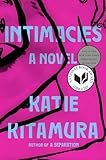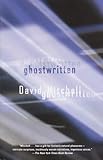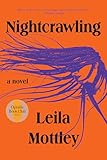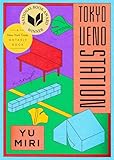Whenever I’m asked to list books I’ve read, my mind goes blank. I used to blame this on childhood test-taking trauma. Later, I blamed it on hormones or hangovers, and still later, I blamed it on age. These days, I mostly blame the pandemic and the way it has smeared discrete experiences into an undifferentiated blur.
Writing a novel has a similar blurring effect on my reading, especially when I’m nearing the end, by which point I am so immersed in my own fictional world that I’m unable to engage deeply with other worlds, other characters, or other books.
This spring, I finished The Book of Form and Emptiness, a novel that had taken me eight years to write. The moment I sent in the copyedited manuscript, I felt a surge of relief and headed to my bookshelf. Finally, I was free to read again.


 I celebrated my liberation with Klara and the Sun, Kazuo Ishiguro’s newest novel about a near-human doll who aspires to human sentience and autonomy. I was scheduled to have an online conversation with Ishiguro in March as part of his virtual book tour, and so I decided to revisit some of his earlier work, too. Never Let Me Go has long been a favorite, and I re-read that with pleasure, followed by The Buried Giant, The Remains of the Day, and finally An Artist of the Floating World. I was halfway through The Unconsoled when my own page proofs arrived, demanding my full and immediate attention, so I never finished, but I did read Ishiguro’s Nobel Prize speech and later watched it online. I felt like I was in school again, diving deeply into an author’s work, tracking the way he plays with genre and form, and the way his novels shape-shift around a thematic core, which many of them share.
I celebrated my liberation with Klara and the Sun, Kazuo Ishiguro’s newest novel about a near-human doll who aspires to human sentience and autonomy. I was scheduled to have an online conversation with Ishiguro in March as part of his virtual book tour, and so I decided to revisit some of his earlier work, too. Never Let Me Go has long been a favorite, and I re-read that with pleasure, followed by The Buried Giant, The Remains of the Day, and finally An Artist of the Floating World. I was halfway through The Unconsoled when my own page proofs arrived, demanding my full and immediate attention, so I never finished, but I did read Ishiguro’s Nobel Prize speech and later watched it online. I felt like I was in school again, diving deeply into an author’s work, tracking the way he plays with genre and form, and the way his novels shape-shift around a thematic core, which many of them share.

 In July, I did another virtual book tour conversation to help launch Violet Kupersmith’s eerie and epic debut novel, Build Your House Around My Body. It’s a time-traveling tale of ghosts and revenge, revolving around the mysterious disappearance of two Vietnamese women, and reading it inspired me to revisit her lush and evocative short story collection, The Frangipani Hotel.
In July, I did another virtual book tour conversation to help launch Violet Kupersmith’s eerie and epic debut novel, Build Your House Around My Body. It’s a time-traveling tale of ghosts and revenge, revolving around the mysterious disappearance of two Vietnamese women, and reading it inspired me to revisit her lush and evocative short story collection, The Frangipani Hotel.
 At the same time, I was also preparing for my own upcoming publication by reading nonfiction books about mental health and trauma—which is not to say that publication is necessarily traumatic or a risk to one’s sanity (although it sometimes is both), but rather that these topics factor into my novel, and I wanted to refresh my understanding. I started with The Body Keeps the Score by Bessel van der Kolk, which friends had been telling me to read ever since 2014, when it was published. If sales are any indication, it is a radical, timely, and transformative book. The U.S. presidential election in 2016 and the traumatizing four years that followed may have accounted for its initial success, but Covid certainly fueled its return to The New York Times bestseller list this year.
At the same time, I was also preparing for my own upcoming publication by reading nonfiction books about mental health and trauma—which is not to say that publication is necessarily traumatic or a risk to one’s sanity (although it sometimes is both), but rather that these topics factor into my novel, and I wanted to refresh my understanding. I started with The Body Keeps the Score by Bessel van der Kolk, which friends had been telling me to read ever since 2014, when it was published. If sales are any indication, it is a radical, timely, and transformative book. The U.S. presidential election in 2016 and the traumatizing four years that followed may have accounted for its initial success, but Covid certainly fueled its return to The New York Times bestseller list this year.


 I next read The Trauma of Everyday Life by the Buddhist psychologist Mark Epstein, and In the Realm of the Hungry Ghosts: Close Encounters with Addiction by psychologist Gabor Maté, two Buddhistically inclined books about trauma-informed approaches to addiction and mental health. Nobody’s Normal: How Culture Created the Stigma of Mental Illness, by medical anthropologist Roy Richard Grinker, rounded out my inquiry with a fascinating historical and cultural perspective on neurological and psychological diversity.
I next read The Trauma of Everyday Life by the Buddhist psychologist Mark Epstein, and In the Realm of the Hungry Ghosts: Close Encounters with Addiction by psychologist Gabor Maté, two Buddhistically inclined books about trauma-informed approaches to addiction and mental health. Nobody’s Normal: How Culture Created the Stigma of Mental Illness, by medical anthropologist Roy Richard Grinker, rounded out my inquiry with a fascinating historical and cultural perspective on neurological and psychological diversity.

 In the summer and fall, I returned to fiction. For my own virtual book tour to launch The Book of Form and Emptiness, I was scheduled to do online events with some of my favorite writers. I started with Katie Kitamura’s new novel, Intimacies, which was longlisted for the National Book Award, and then inspired by the quiet, spare intensity of her prose and plotting, I reread her earlier novel, A Separation.
In the summer and fall, I returned to fiction. For my own virtual book tour to launch The Book of Form and Emptiness, I was scheduled to do online events with some of my favorite writers. I started with Katie Kitamura’s new novel, Intimacies, which was longlisted for the National Book Award, and then inspired by the quiet, spare intensity of her prose and plotting, I reread her earlier novel, A Separation.

 Elizabeth McCracken is a writer I’ve admired ever since I first read The Giant’s House when it came out in 1998. Much of the story is set in a library, and I’d been wanting to revisit it, since I was writing about libraries, too. It was such a pleasure to reconnect with Peggy Cort, a cranky, contrarian librarian, and James, the giant of her dreams. I also read McCracken’s latest book, The Souvenir Museum, a wonderful short story collection, which was also on the National Book Award longlist.
Elizabeth McCracken is a writer I’ve admired ever since I first read The Giant’s House when it came out in 1998. Much of the story is set in a library, and I’d been wanting to revisit it, since I was writing about libraries, too. It was such a pleasure to reconnect with Peggy Cort, a cranky, contrarian librarian, and James, the giant of her dreams. I also read McCracken’s latest book, The Souvenir Museum, a wonderful short story collection, which was also on the National Book Award longlist.

 I’ve long felt a sense of literary kinship, largely aspirational, with Aimee Bender, a master of subtle magic, eccentric psychologies, and stunning prose. The Peculiar Sadness of Lemon Cake was the first book of hers I read when it was published in 2010. Rereading it, and then reading her recent novel, The Butterfly Lampshade, I was struck by how the feeling of kinship extends to our young protagonists. Her Rose, who can taste emotions in food, and Francie, who sees images come into being, could easily be sisters to my Benny, who can hear inanimate objects speak.
I’ve long felt a sense of literary kinship, largely aspirational, with Aimee Bender, a master of subtle magic, eccentric psychologies, and stunning prose. The Peculiar Sadness of Lemon Cake was the first book of hers I read when it was published in 2010. Rereading it, and then reading her recent novel, The Butterfly Lampshade, I was struck by how the feeling of kinship extends to our young protagonists. Her Rose, who can taste emotions in food, and Francie, who sees images come into being, could easily be sisters to my Benny, who can hear inanimate objects speak.

 I read Madeline Miller’s The Song of Achilles when it won the Orange Prize in 2012, and then last winter, during the height of the lockdown, I needed an incentive to get myself to leave the house, and so I decided to listen to the audiobook. I’m picky about audiobooks, and if I don’t like the narrator, I immediately stop listening (this has happened so often that it seems Audible has stopped giving me refunds). Happily, Frazer Douglas’s reading of Song of Achilles is riveting, and when it came time to read Circe, I decided to listen to it, too. I was not disappointed. Perdita Weeks is brilliant, and the writing was so enchanting, I had to buy the paperback so I could revisit the story on the page. These two novels were the perfect antidotes to the pandemic, at once thrilling and consoling, because what is Covid compared to the suffering that Greek gods can inflict on us mortals?
I read Madeline Miller’s The Song of Achilles when it won the Orange Prize in 2012, and then last winter, during the height of the lockdown, I needed an incentive to get myself to leave the house, and so I decided to listen to the audiobook. I’m picky about audiobooks, and if I don’t like the narrator, I immediately stop listening (this has happened so often that it seems Audible has stopped giving me refunds). Happily, Frazer Douglas’s reading of Song of Achilles is riveting, and when it came time to read Circe, I decided to listen to it, too. I was not disappointed. Perdita Weeks is brilliant, and the writing was so enchanting, I had to buy the paperback so I could revisit the story on the page. These two novels were the perfect antidotes to the pandemic, at once thrilling and consoling, because what is Covid compared to the suffering that Greek gods can inflict on us mortals?

 Also on my virtual tour schedule was a conversation with David Mitchell, a writer whose work I have loved ever since I read Ghostwritten. I was having such good luck with audiobooks that I decided to listen to Black Swan Green, one of the few of his novels I’d never read. The best audiobooks, like the best film adaptations, add a dimension that is impossible to render on the page, and Kirby Heyborne accomplishes just this beautifully with his narration. And here again, I felt a sense of lineage and connection between our fictional characters; 14-year-old Benny Oh would have liked to meet Jason Taylor, the 13-year-old protagonist of Black Swan Green. Both boys hear voices. They could have been friends.
Also on my virtual tour schedule was a conversation with David Mitchell, a writer whose work I have loved ever since I read Ghostwritten. I was having such good luck with audiobooks that I decided to listen to Black Swan Green, one of the few of his novels I’d never read. The best audiobooks, like the best film adaptations, add a dimension that is impossible to render on the page, and Kirby Heyborne accomplishes just this beautifully with his narration. And here again, I felt a sense of lineage and connection between our fictional characters; 14-year-old Benny Oh would have liked to meet Jason Taylor, the 13-year-old protagonist of Black Swan Green. Both boys hear voices. They could have been friends.


 I didn’t need to re-read Karen Joy Fowler’s work, because I know it so well. I’ve been a fan of all her work, from Sarah Canary to We Are Completely All Beside Ourselves so it was a thrill to read the galleys for her magnificent new historical novel, Booth, which will be published in March, 2022. What can I say? It’s about the about the wildly eccentric thespian siblings of John Wilkes Booth, set during the Civil War, during the period leading up Lincoln’s assassination. I love KJF’s mind, her dry, subtle humor. No one writes sentences like hers.
I didn’t need to re-read Karen Joy Fowler’s work, because I know it so well. I’ve been a fan of all her work, from Sarah Canary to We Are Completely All Beside Ourselves so it was a thrill to read the galleys for her magnificent new historical novel, Booth, which will be published in March, 2022. What can I say? It’s about the about the wildly eccentric thespian siblings of John Wilkes Booth, set during the Civil War, during the period leading up Lincoln’s assassination. I love KJF’s mind, her dry, subtle humor. No one writes sentences like hers.


 I receive a lot of galleys from publishers looking for blurbs, but while it’s always fun to be among the first to read these new books, when I’m in the throes of writing, I have to decline. Now that I’m newly liberated, however, I’ve been reading more, starting with Woman, Eating, a magnificent debut by Claire Kohda, about a young mixed-race vampire with an eating disorder, who can’t quite make herself feed on her human friends, which will be published in April next year. I followed this with Nightcrawling, another stunning debut due out in May, by Leila Mottley about a young Black woman in Oakland, who becomes a key witness in a sex and prostitution scandal involving the city’s corrupt police department. I also read and enthusiastically endorsed Speaking Out of Place: Getting Our Political Voices Back by David Palumbo-Liu, professor of comparative literature at Stanford, and Alive Until You’re Dead: Notes on the Home Stretch, a beautiful collection of Zen Buddhist meditations on old age and dying, by Susan Moon.
I receive a lot of galleys from publishers looking for blurbs, but while it’s always fun to be among the first to read these new books, when I’m in the throes of writing, I have to decline. Now that I’m newly liberated, however, I’ve been reading more, starting with Woman, Eating, a magnificent debut by Claire Kohda, about a young mixed-race vampire with an eating disorder, who can’t quite make herself feed on her human friends, which will be published in April next year. I followed this with Nightcrawling, another stunning debut due out in May, by Leila Mottley about a young Black woman in Oakland, who becomes a key witness in a sex and prostitution scandal involving the city’s corrupt police department. I also read and enthusiastically endorsed Speaking Out of Place: Getting Our Political Voices Back by David Palumbo-Liu, professor of comparative literature at Stanford, and Alive Until You’re Dead: Notes on the Home Stretch, a beautiful collection of Zen Buddhist meditations on old age and dying, by Susan Moon.
And finally, here are some books that I read just because I had the time:
 Double Blind: a novel that made me laugh so hard, I had to put it down every couple of pages to wipe the tears from my eyes. Nobody can write a party scene like Edward St. Aubyn, but this is a serious book, too, serious in its social satire, and serious in its deep appreciation of what it is to be human.
Double Blind: a novel that made me laugh so hard, I had to put it down every couple of pages to wipe the tears from my eyes. Nobody can write a party scene like Edward St. Aubyn, but this is a serious book, too, serious in its social satire, and serious in its deep appreciation of what it is to be human.
Hamnet: by Maggie O’Farrell is a timely book about the plague, based on the life and death of Shakespeare’s son. I listened to this as an audiobook, beautifully narrated by Ell Potter, and again, part way though, I bought the paperback so I could follow it on the page as well.
 Tokyo Ueno Station, is a quiet, powerful story told from the point of view of a homeless ghost. Yū Miri is a Korean novelist living in Japan, and the novel made me yearn for Tokyo.
Tokyo Ueno Station, is a quiet, powerful story told from the point of view of a homeless ghost. Yū Miri is a Korean novelist living in Japan, and the novel made me yearn for Tokyo.
Volume One of Lydia Davis’s Essays makes me see the world with more clarity and write it with more precision.
 And finally, When You Greet Me, I Bow: Notes and Reflections From a Life in Zen, another profoundly wise and beautiful collection of essays by my Zen teacher Norman Fischer. His thoughts on the relationship between language, imagination, and the emptiness teachings have inspired my last two novels.
And finally, When You Greet Me, I Bow: Notes and Reflections From a Life in Zen, another profoundly wise and beautiful collection of essays by my Zen teacher Norman Fischer. His thoughts on the relationship between language, imagination, and the emptiness teachings have inspired my last two novels.
As I look back at this list, I see that many of the books I’ve read this year were books I’d read before, and as I’ve been writing this, these books seem to have found their way off my bookshelf and back to my desk again. And since they are right here, sitting at my elbow, I can’t resist opening and leafing through them, which is why this essay is taking me longer to write than it should. If this continues, if I don’t stop writing and rereading, I will get stuck in 2021, so I’ll just wrap up with a few words from Norman Fischer’s essay, “Notes on Thinking, Writing, and Emptiness,” which seem like a fitting ending for this reflection on books:
We are language-created creatures….It seems to me that all uses of language, including almost all thinking, produces imaginary thoughts and experiences; language is an act of imagination. We imagine, through our words and ideas, a world we can live in. We imagine ourselves and one another. And then we think about and write about this imaginary world.
More from A Year in Reading 2021 (opens in a new tab)
Don’t miss: A Year in Reading 2020, 2019, 2018, 2017, 2016, 2015, 2014, 2013, 2012, 2011, 2010, 2009, 2008, 2007, 2006, 2005









